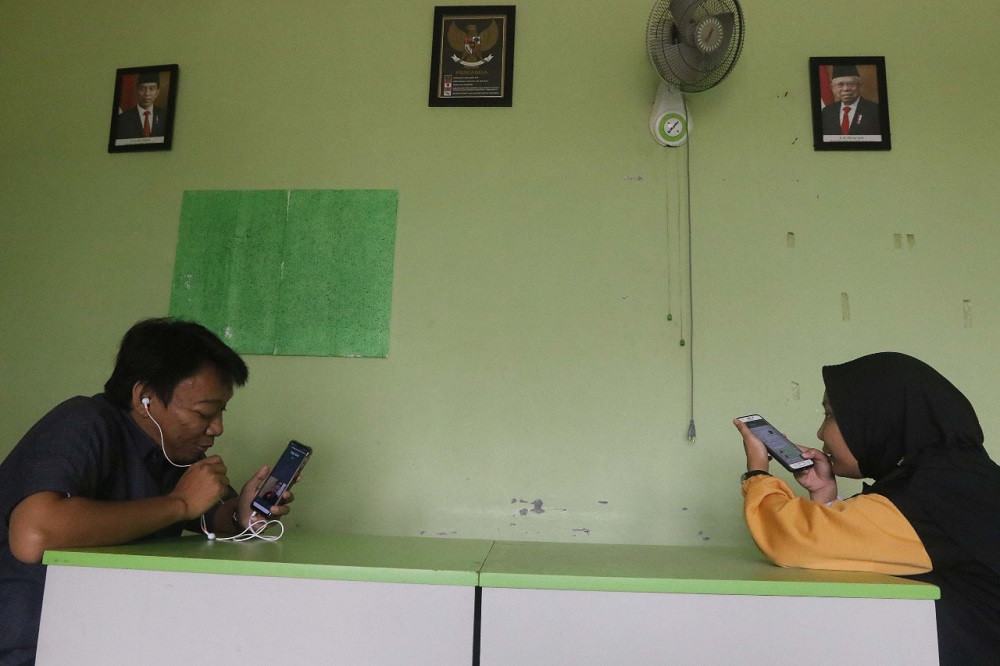Future bleak for students if school closure ‘prolonged’
A recently published World Bank study presents new estimates correlating learning loss with future earning losses amid the prolonged school closure, while the education ministry assesses potential solutions for learning recovery.
Change Size

P
rolonged school closure due to the COVID-19 pandemic has deepened the learning crisis in Indonesia, as learning loss puts students at risk of notable income loss in the future, reveals a World Bank study published on Sept. 16.
The World Bank study, on overcoming learning losses and improving outcomes from the pandemic, suggests that students could experience between 0.9 to 1.2 years of learning loss during the 1.5-year school closure.
Even before the pandemic, the national education system delivered learning at levels far below what Indonesian children and youth need today, with students expected to attend an average 12.4 years of schooling but learning the equivalent of just 7.8 years.
The report estimates that the pandemic could further reduce the learning-adjusted years of schooling (LAYS) from 7.8 years to between 6.6 and 6.9 years.
The nationwide school closure has also negatively impacted student literacy development, leaving more than 80 percent of 15-year-olds languishing below the minimum reading proficiency level of the Organisation for Economic Cooperation and Development (OECD), a marked increase from 70 percent in 2018.
And since human capital and future earnings are correlated, the World Bank estimates that learning loss due to the pandemic could cost each student US$408 (Rp 6 million) to $578 (Rp 8 million) in future annual earnings.
As a whole, this means that the lifetime earning losses of all students could amount to $253-$359 billion, or between 24 and 34 percent of gross domestic product in 2020.
Read also: Looming learning loss prompts push to reopen schools
Delayed reopenings
Learning loss, generally understood as the idea that learning decays over time if students don’t engage with it systematically and in person, has become a constant concern, as most of the nation’s 68 million primary and secondary school students have been away from the classroom since March 2020.
Even though regional administrators have been able to use their discretion to gradually reopen schools since July 2020, less than half of all schools nationwide had resumed in-person learning as of Tuesday, according to the Education, Culture, Research and Technology Ministry.
The sluggish vaccine rollout for teachers and students aged 12-17, as well as persisting COVID-19 transmission, had made local leaders wary of sending children back to school, said Jumeri, the education ministry’s early childhood, primary and secondary education director general.
“Progress in reopening schools remains very slow, even though the pandemic is subsiding. Many local leaders are taking a conservative and extremely cautious stance in allowing schools in their regions to reopen,” he said on Tuesday.
Only 40 percent of the country’s 5.5 million teachers are fully vaccinated to date, while around 26.5 million students aged 12-17, or a mere 9 percent of this demographic segment, are fully vaccinated.
While vaccination is not a requirement to reopen a school, schools whose teachers are fully vaccinated are required to offer the option of reopening.
Read also: COVID-19 schooling: Learning from home in Lombok
Difficulties and disparity
According to the World Bank study, though most students were able to continue with their schooling during the pandemic, the quality of learning was questionable while many students struggled to adapt to remote learning.
Seventy-one percent of student respondents said they experienced at least one constraint in learning online, including limited internet access, difficulty concentrating, lack of digital devices, limited study space at home, and lack of parental guidance.
Teachers also faced extreme difficulty in adapting to new technologies for delivering online lessons, with many feeling unguided, overwhelmed and overworked.
Prolonged school closures have also led to unequal learning among students nationwide, as time spent on remote learning varied significantly across regions and socioeconomic groups.
The World Bank said that students from lower income households spent an average 2.2 hours per day on at-home learning, while those from households with higher incomes spent an average 2.7 hours a day. The figures underscored the gap in access to adequate learning environments and facilities.
Read also: Hybrid learning could be key to students transitioning from online to offline
Trialing solutions
Properly equipping teachers so they could take advantage of remote learning opportunities had grown in both relevance and importance in the world’s largest archipelagic nation.
Iwan Syahril, the ministry’s director general of teachers and education staff, said the government would continue to push more schools in regions at lower COVID-19 risk levels to resume classroom learning to avoid widening the learning loss projection.
“We've also created an emergency curriculum for online learning that is simpler than the previous one as a guideline for teachers,” Iwan told The Jakarta Post on Wednesday.
“Our research shows that this curriculum has many positive impacts for online learning, and [that it] has helped teachers to [deliver] more meaningful lessons,” he added.
To mitigate and recover from learning loss, Iwan said the ministry was preparing an assessment to identify students who were falling behind and try to evaluate learning loss from their experiences.
The ministry also planned to provide online training for teachers so they could interpret and act on the assessment’s results to provide differentiated assistance and individualized support, such as delivering learning at the appropriate level to encourage recovery among struggling students.
In a bid to improve the quality of online education and teacher capacity in delivering remote instruction, the ministry had provided technical training for some 240,000 teachers nationwide on using educational technology, Iwan said.









